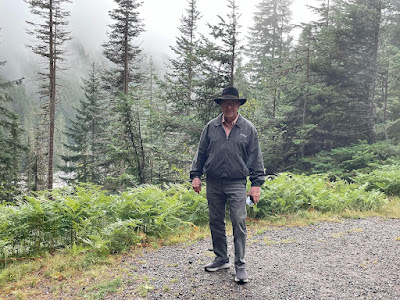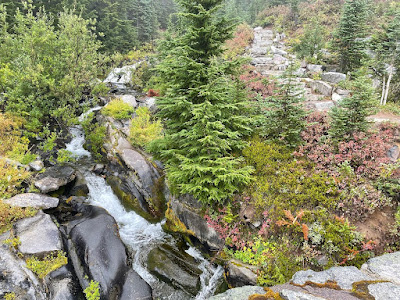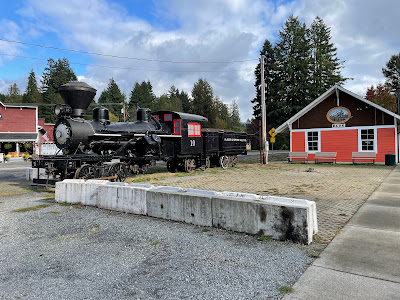The weather forecast for today was less than promising. Since we’re not able to order the weather we want when we want it, we just have to go with the flow. Such was the situation for today’s visit to Mount Rainier. While we have always been aware of Mt. Rainier, we weren’t totally prepared for what we were to experience whether cool or warm, wet or dry, sunny or cloudy. Ascending to 14,410 feet above sea level, Mount Rainier stands tall in the Washington landscape. An active volcano, it is the most glaciated peak in the contiguous U.S.A. and is the beginning point for five rivers of significance.
Gig Harbor, where we have spent the night while in the Seattle-Tacoma area, is several miles north and west of the National Park. We started out a little later than normal because it was rainy and cloudy. Getting to our intended destination took nearly two hours. We wanted to get to Paradise, the area on the south-central edge of the Park. To get there we entered through Nisqually which is on the southwest corner. (MoRa, as the stickers denote, has four entry points.) It seemed to get worse as the day went on.
Martha had done a little preparation for our visit and knew that our first stop would be Longmire and a visit to the small museum there. By small, we’re talking a cabin that was 16' x 24' or so. It was the first ranger office at the Park. Longmire serves as a small and permanent community for employees and also has other amenities for park visitors (tourists).
From Longmire, we traveled toward Paradise and the Henry Jackson Visitor Center. We had packed a picnic lunch, but at the 5,400-foot elevation and cold, misting rain, we opted to picnic in the car! As we looped around to exit the picnic area, Martha spotted three deer grazing next to the roadway. So as not to scare them away, she inched the car closer to them so Byron could get a picture.
We arrived at the Visitor Center in Paradise. Though we had seen few cars on the road, we saw a nearly full parking lot. It was obvious that “this was the place” at which to be even on a cold, rainy day at 45° F. We always like to see the introductory videos so we watched the short, 20-minute film of the Park. It was quite informative and pointed out that Mt. Rainier, though the fifth National Park, was the first park that had been created with a careful plan in mind for use and maintenance. For instance, the structures that were developed became the standard for implementation in many of the other parks of the NPS. For sure, Paradise has its name for good reason because it offers the best of all there is to experience at Mount Rainier.
As we were walking away from the Henry Jackson Memorial Visitor Center, we remarked to each other that we now have a good reason to return. The many glaciers, rivers, trails, variety of scenery, and weather developed here are truly amazing. Just think, we were only about one-third of the elevation of Rainier which is above 14,000 feet. More to see? Yes, indeed! Subalpine wildflower meadows ring the icy volcano while ancient forests surround Mount Rainier’s lower slopes. Wildlife abounds in the park’s ecosystems. A lifetime of discovery awaits and we were here only a few hours. The bucket list has not been shortened.
On the return to the RV resort in Gig Harbor, we stopped in Elbe for some huckleberry ice cream. Huckleberry flavoring is popular in the northern half of the Rocky Mountains.










No comments:
Post a Comment